We support our Publishers and Content Creators. You can view this story on their website by CLICKING HERE.

Abortion on the Ballot
Abortion is on the ballot this year in several states, including Arizona, Colorado, Florida, Maryland, Missouri, Montana, Nebraska, Nevada, New York, and South Dakota. Although the language slightly differs among these ballot measures, most of these initiatives ask voters to amend their state constitutions to enshrine an unfettered right to abortion throughout all nine months of pregnancy. These pro-abortion ballot measures pose a serious threat to life and will have devastating repercussions for women and preborn children if passed. Unfortunately, these ballot measures are deceptively worded and advertised. To help educate the public on the harms of these pro-abortion ballot measures, AUL carefully analyzed the upcoming 2024 ballot measures and published legal analyses for each state. Here is everything you need to know about the 2024 abortion ballot initiatives, state by state.
Arizona Proposition 139: “Right to Abortion Initiative”
Arizona’s pro-abortion ballot measure enshrines constitutional protection for a “fundamental right to abortion.” Additionally, the ballot measure prohibits the state from regulating abortion before viability and after viability if the abortionist determines that the abortion is “necessary to protect the life or physical or mental health of the pregnant individual.” This language effectively authorizes abortion-on-demand throughout all nine months of pregnancy. Notably, the ballot measure also prohibits the state from penalizing “any individual or entity for aiding or assisting a pregnant individual in exercising” their “right to abortion.” Thus, under the initiative, Arizona cannot prohibit a sex trafficker or abusive partner from bringing their victim to an abortion clinic to have a coerced abortion since it is the women constitutionally protected “right.” Consequently, the initiative prevents the state from enacting necessary safeguards for authentic choice, which will increase the number of unwanted abortions. To learn more about the harms of this ballot measure, read AUL’s legal analysis.
Colorado Amendment 79: “Right to Abortion and Health Insurance Coverage Initiative”
Colorado’s pro-abortion ballot measure asks Coloradans to declare 1) that the the state may not “discriminate” against the termination of a human life in the womb, and 2) that every Coloradan must pay to extinguish that life with their tax dollars. Specifically, the ballot measure amends the state constitution to prohibit the government from “deny[ing], imped[ing], or discriminat[ing] against the exercise of [the right to abortion], including prohibiting health insurance coverage for abortion.” The amendment would create a new protected class for abortion, which would deny any protections preborn children may have enjoyed, such as protections against discrimination on the basis of race, gender, religion. Further, by forcing taxpayers to fund abortions throughout all nine months of pregnancy, the ballot measure would create incentives for state programs to encourage and promote abortion. To learn more about the harms of this ballot measure, read AUL’s legal analysis.
Florida Amendment 4: “Right to Abortion Initiative”
Florida’s pro-abortion ballot measure prohibits the state from enacting any law that “prohibit[s], penalize[s], delay[s], or restrict[s] abortion before viability or when necessary to protect the patient’s health, as determined by the patient’s healthcare provider.” The ballot measure uses deceptive language that downplays the ramifications of the radical amendment. Because of the vague and ambiguous language, Florida’s attorney general asked the state Supreme Court to provide an advisory opinion on the validity of the proposed amendment. The ballot measure includes language that would allow for a broad “health” exception. This would authorize abortion-on-demand throughout all nine months of pregnancy as long as the abortionist determined that the abortion was “necessary to protect the patient’s health.” This ballot measure runs contrary to the state’s strong pro-life culture and would lead to the potential elimination of the state’s life-affirming laws, including the state’s protections for preborn life after six weeks’ gestation. To learn more about the harms of this ballot measure, read AUL’s legal analysis.
Maryland Question 1: “Maryland Right to Reproductive Freedom Amendment”
The Maryland pro-abortion ballot measure would enshrine an unfettered “right to reproductive freedom, including but not limited to the ability to make and effectuate decisions to prevent, continue, or end one’s own pregnancy.” The misleading phrasing of the ballot measure makes it appear as though the state currently restricts or is attempting to restrict individuals from making decisions about contraceptives or continuing a pregnancy, which is false. Maryland already has little to no legal protections for preborn life, however, enshrining constitutional protection for abortion-on-demand would impede the state from enacting any future protections for women and preborn life, such as protections against coerced abortions. Furthermore, due to the vague language of the ballot measure, the amendment could easily be interpreted to touch on all reproductive maters, including laws regulating pregnancy, prenatal care, childbirth, postpartum care, birth control, etc. This may prevent the state from regulating any measure concerning a woman’s pregnancy. As a result, the state would be prohibited from enacting commonsense protections for women in various areas of reproductive health, not just abortion. To learn more about the harms of this ballot measure, read AUL’s legal analysis.
Missouri Amendment 3:“The Right to Reproductive Freedom Initiative”
The Missouri pro-abortion ballot measure broadly prohibits the state from “deny[ing] or infring[ing] upon a person’s fundamental right to reproductive freedom, which is the right to make and carry out decisions about all matters relating to reproductive health care, including but not limited to . . . abortion care.” Further, the ballot measure states that any law that interferes or restricts this purported “right to reproductive freedom” in any way, it will be “presumed invalid . . .” This will lead to abortion activists challenging the validity of all existing life-affirming laws in the state. Furthermore, similar to other pro-abortion ballot measures, the Missouri initiative includes a broad exception for the “life or physical or mental health of the pregnant person,” thereby authorizing abortion-on-demand throughout all nine months of pregnancy. The ballot measure also defines “fetal viability,” and in doing so, imposes a vague, arbitrary standard for determining if a preborn child can survive outside the womb. To learn more about the harms of this ballot measure, read AUL’s legal analysis.
Montana Ballot Issue #14: “The Right to Abortion Initiative”
The Montana pro-abortion ballot measure explicitly forbids the state from enacting laws that protect women and preborn children from abortion violence up to viability and includes an unlimited exception for abortions after viability “to protect the pregnant patient’s life or health.” In other words, the ballot measure ensures constitutional protection for elective abortions up until a baby’s birthdate. This measure comes on the heels of the Montana Supreme Court’s decision to invalidate the state’s parental notification law. If the composition of the Montana Supreme Court were ever to change to one that recognizes the truth about abortion, the ballot measure would tie their hands. The ballot measure continues the work of abortion activists to turn Montanan’s life-affirming state into an abortion destination that endangers the health and safety of its residents both inside and outside the womb. To learn more about the harms of this ballot measure, read AUL’s legal analysis.
Nebraska Initiative 434: “Protect Women and Children Initiative” and Initiative 439: “Protect the Right to Abortion Initiative”
Nebraska is in a unique position because the state has two ballot measures in play. The first initiative, Protect the Right to Abortion (PRA), seeks to contrive a right to abortion-on-demand throughout all nine months of pregnancy. The second initiative, Protect Women and Children (PWC), ensures constitutional protection for life after 12 weeks’ gestation. More specifically, the PRA measure would amend the constitution to state that “[a]ll persons shall have a fundamental right to abortion until fetal viability, or when needed to protect the life or health of the pregnant patient . . .” On the other hand, the PWC measure would amend the constitution to state that “unborn children shall be protected from abortion in the second and third trimesters.” Depending on which, if any, initiative voters approve of, Nebraska’s legal and cultural makeup could look drastically different. The PRA initiative would threaten the state’s ability to enact any future life-affirming protections, while the PWC initiative would have the opposite effect. The PRA initiative would abandon women and preborn children to an unregulated abortion regime, while the PWC initiative would ensure that there are necessary constitutional safeguards in place to protect women and preborn children from abortion violence. To learn more about these ballot measures, read AUL’s legal analysis.
Nevada Question 6: “The Nevada Reproductive Rights Amendment”
Nevada’s pro-abortion ballot measure amends the state’s constitution to protect “a fundamental right to abortion performed or administered by a qualified health care practitioner until fetal viability, or when needed to protect the life or health of the pregnant patient. . .” Similar to other ballot measures across the states, Nevada’s ballot measure includes a broad exception for abortions after viability, authorizing abortion-on-demand. Additionally, the ballot measure includes vague, misleading language to make it appear as though the state is restricting or attempting to restrict women’s access to contraception, fertility and miscarriage treatment, or prenatal care. Further, the ballot measure includes a definition of viability that provides abortionists with the ultimate trump card by 1) leaving the question of viability up to the abortionist’s subjective opinion, and 2) given the abortionists broad discretion for abortions after viability as long as the abortionists deems the abortion “necessary” for the woman’s “health.” To learn more about the harms of this ballot measure, read AUL’s legal analysis.
New York Proposal Number One: “The New York Equal Protection of Law Amendment”
The language of New York’s pro-abortion ballot measure differs the most drastically from other state’s initiatives. It seeks to amend the state constitution to add “sex, including . . . pregnancy, pregnancy outcomes, and reproductive healthcare and autonomy” as protected classes under the state’s equal protection clause. The ballot measure asks New Yorkers to declare that a person’s decision to terminate a human life in the womb constitutes a protected class – meaning state action, such as ensuring a woman is fully informed about an abortion procedure or crafting health and safety requirements for abortion facilities, would be an act of discrimination. The ballot measure would place unfettered abortion on the same legal and moral plane as age, ethnicity, and other well-recognized bases for protection. If abortion becomes not just a constitutional right, but also a protected class in New York, it will be virtually impossible to enact commonsense legislation that seeks to protect women and preborn children from abortion violence. To learn more about the harms of this ballot measure, read AUL’s legal analysis.
South Dakota Constitutional Amendment G: “Right to Abortion Initiative”
South Dakota’s pro-abortion ballot measure 1) prohibits the state from regulating abortion during the first trimester, 2) limits state regulations on abortion in the second trimester unless the regulation is “reasonably related to the physical health of the pregnant woman,” and 3) prohibits state regulations on third trimester abortions if the abortionist deems the abortion “necessary . . . to preserve the life and health of the pregnant woman.” South Dakota’s ballot measure goes well beyond Roe v. Wade and ensures constitutional protection for abortion-on-demand up until a preborn baby’s birth date. Further, the state has several pro-life protections currently in place for women, adolescents, and their preborn children. However, the ballot measure places these laws at risk of being challenged in court or being removed by the legislature. To learn more about the harms of this ballot measure, read AUL’s legal analysis.

 Conservative
Conservative  Search
Search Trending
Trending Current News
Current News 





